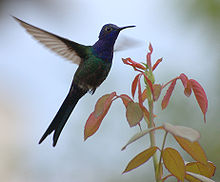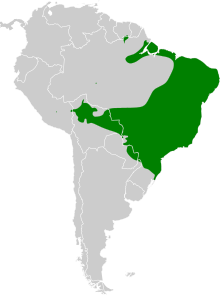Broad-winged hummingbird
| Broad-winged hummingbird | ||||||||||
|---|---|---|---|---|---|---|---|---|---|---|

Broad- winged hummingbird ( Eupetomena macroura ) |
||||||||||
| Systematics | ||||||||||
|
||||||||||
| Scientific name of the genus | ||||||||||
| Eupetomena | ||||||||||
| Gould , 1853 | ||||||||||
| Scientific name of the species | ||||||||||
| Eupetomena macroura | ||||||||||
| ( Gmelin , 1788) |
The broad- winged hummingbird ( Eupetomena macroura ), blue fork-tailed hummingbird or swallow hummingbird is a species of hummingbirds (Trochilidae) native to South America .
features
Broad-winged hummingbirds are about 15 to 17 cm tall, with the wings 7.8 cm, the deeply forked tail 90 mm and the beak 21 mm long. The head, neck and chest are dark purple blue. The back, the underside and the wing covers have a dark green sheen. Some of the upper tail coverts are colored dark wine red, while the tail and under tail coverts are steel blue. The wings shimmer blackish purple. The bill and feet are black. The females are a little duller in color and a little smaller. While the males weigh around 8 g, the females are a little lighter at around 6 g.
Fledglings have brown feather trimmings on their heads and backs.
food
The food of the animals consists of the nectar of plants as well as of small insects .
distribution and habitat
They occur in open, loose shrubbery and tree-covered camp areas. They can also be found in the cerrados of Brazil. It is considered the best-known species of hummingbird among Brazilians, as it often looks for food in gardens.
Reproduction
They build the bowl-shaped nests in the branches and in forks of branches. They mainly consist of various flying seeds and cotton wool. The outer walls are decorated with moss and lichen, which are tightly wrapped with spider threads. The construction takes place at a height of about 1.5 to 3 meters, but can also reach up to 12 meters. The breeding period is 16 days, with the offspring being nestled for about 25 days.
Subspecies
Five subspecies of the species are known so far.
- Eupetomena macroura macroura ( Gmelin, JF , 1788) - The nominate form occurs in the Guyanas, in north, central and southeast of Brazil, as well as in Paraguay.
- Eupetomena macroura simoni Hellmayr , 1929 - This subspecies is widespread in northeastern Brazil.
- Eupetomena macroura cyanoviridis Grantsau , 1988 - This subspecies is distributed in southeastern Brazil.
- Eupetomena macroura hirundo Gould , 1875. This subspecies occurs in eastern Peru.
- Eupetomena macroura boliviana Zimmer, JT , 1950 - This subspecies is found in northwestern Bolivia.
Etymology and history of research
Johann Friedrich Gmelin described the hummingbird under the name Trochilus macrourus . It was John Gould who classified him in the new genus Eupetomena in his deliveries of 6 of his hummingbird tablets in 1853 . This name is of Greek origin and is made up of the words "eu ευ " for "fine, good" and "petomenos, petomai πετομενος, πετομαι " for "flying, flying". The specific epithet »macroura« is also a Greek structure from »makros μακρος « for »long« and »-ouros -ουρος « for »-tailed«. "Simoni" is dedicated to Eugène Simon , who was the first to try to divide this species into subspecies. "Cyanoviridis" is a Latin combination of "cyaneus" for "dark blue" and "viridis" for "green". "Hirundo" is the Latin word for "swallow". »Boliviana« stands for the country »Bolivia«.
literature
- Yoshika Oniki , Edwin O'Neill Willis: Nesting behavior of the swallow-tailed hummingbird, Eupetomena macroura (Trochilidae, Aves) . In: Revista Brasileira de Biologia . tape 60 , no. 4 , 2000, pp. 655–662 ( online [PDF; 123 kB ; accessed on July 12, 2014]).
- James A. Jobling: Helm Dictionary of Scientific Bird Names . Christopher Helm, London 2010, ISBN 978-1-4081-2501-4 .
- Johann Friedrich Gmelin: Systema Naturae per Regna Tria Naturae, Secundum Classes, Ordines, Genera, Species, Cum Characteribus, Differentiis, Synonymis, Locis . tape 1 . Georg Emanuel Beer, Leipzig 1788 ( online [accessed July 12, 2014]).
- John Todd Zimmer : Studies of Peruvian birds. No. 56, The genera Eutoxeres, Campylopterus, Eupetomena, and Florisuga . In: American Museum novitates . No. 1450 , 1950, pp. 1–15 ( online [PDF; 1.3 MB ; accessed on July 12, 2014]).
- John Gould: A monograph of the Trochilidæ, or family of humming-birds . tape 2 , delivery 6. Taylor and Francis, London 1853 ( online [accessed June 28, 2014]).
- John Gould: On a new species of the genus Eupetomena . In: The Annals and magazine of natural history; zoology, botany, and geology (= 4 ). tape 16 , 1875, pp. 370 ( online [accessed July 12, 2014]).
- Carl Eduard Hellmayr: A contribution to the ornithology of north-eastern Brazil . In: Field Museum Natural History Publications (= Zoological Series ). tape 12 , no. 18 , 1929, pp. 235–501 ( online [accessed July 12, 2014]).
- Rolf Grantsau : The hummingbirds of Brazil . A key for all hummingbird shapes in Brazil. Expressão e Cultura, Rio de Janeiro 1988, ISBN 85-208-0101-3 .
Web links
- Eupetomena macroura inthe IUCN Red List of Threatened Species 2014.1. Listed by: BirdLife International, 2012. Retrieved July 12, 2014.
- BirdLife International: Species Factsheet - Swallow-tailed Hummingbird ( Eupetomena macroura ) . Retrieved July 12, 2014.
- Videos, photos and sound recordings of Swallow-tailed Hummingbird (Campylopterus macrourus) in the Internet Bird Collection
- Blue fork-tailed hummingbird ( Eupetomena macroura ) at Avibase; Retrieved July 12, 2014.
- Eupetomena macroura in the Integrated Taxonomic Information System (ITIS). Retrieved July 12, 2014.
- xeno-canto: Sound recordings - Swallow-tailed Hummingbird ( Eupetomena macroura )
Individual evidence
- ^ A b John Gould (1853), plate 42, volume 2. This corresponds to delivery 6, plate 1 from 1853.
- ↑ a b c d Rolf Grantsau, p. 56.
- ↑ Yokshika Oniki, p 655ff.
- ^ IOC World Bird List Hummingbirds
- ↑ a b Johann Friedrich Gmelin, p. 487.
- ^ Carl Eduard Hellmayr, p. 386.
- ^ Rolf Grantsau, p. 57.
- ^ John Gould (1875), p. 370.
- ↑ John Todd Zimmer, p. 6.
- ↑ James A. Jobling, p. 152.
- ↑ James A. Jobling, p. 236.
- ↑ Carl Eduard Hellmayr, p. 387.
- ↑ James A. Jobling, p. 126.
- ↑ James A. Jobling, p. 193.
- ^ John Todd Zimmer, p. 7, circulation area

